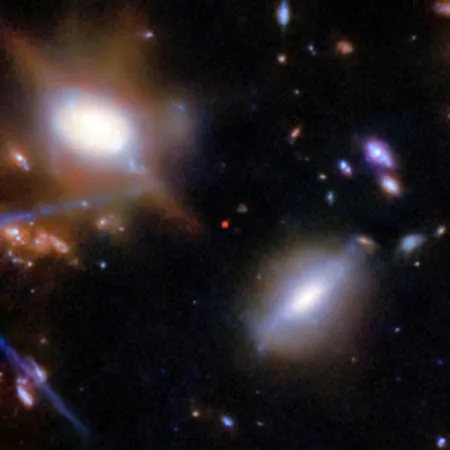
Astronomers Uncover Early Galaxy Creating Stunning 'Bubbles' in Cosmic Fog
2025-04-07
Author: Rajesh
The early universe was anything but serene; it was a chaotic firestorm of cosmic events. Born from the Big Bang, the universe cooled as it expanded, and gravity began to weave matter together, leading to the formation of galaxies from vast clouds of primordial gas shrouded in dense fog. These emerging galaxies began to create distinct bubbles in this metaphorical fog, marking a significant transformation in the cosmos.
The timeline of when these galaxies started to create such bubbles has been a mystery for scientists. However, groundbreaking discoveries are now pushing back the boundaries of when we think the first galaxies and their effects became evident—potentially closer to the Big Bang than previously imagined.
During the first few hundred million years after the Big Bang, the universe was shrouded in a thick blanket of neutral hydrogen gas, which obscured the first galaxies glowing in ultraviolet (UV) light. This neutral hydrogen acted like a cosmic smokescreen, blocking any observation of these early bright objects. Consequently, observing these early galaxies was nearly impossible, as they emitted light trapped within a fog that rendered them invisible to telescopes.
However, this is where the exciting concept known as the Epoch of Reionization comes into play. This critical period represents a dramatic shift when the first stars and galaxies not only lit up the cosmos but began to ionize the surrounding neutral hydrogen, effectively clearing the way for light to travel unimpeded. Until recently, astronomers believed this pivotal reionization moment began around 500 million years after the Big Bang, taking another half a billion years to complete.
However, new research from astronomers at the Cosmic Dawn Center (DAWN) has overturned this timeline, offering fresh insights into the universe's formative years. Their study focuses on a galaxy named JADES-GS-z13-1, one of the oldest galaxies identified. Its extraordinary brightness allowed it to stand out amidst the cosmic fog.
According to Joris Witstok, the study's lead researcher from the University of Cambridge, young galaxies emit the brightest light at a specific wavelength associated with hydrogen, referred to as 'Lyman alpha' light. This short wavelength makes the light prone to absorption by its environment, explaining why galaxies from the universe's early years appeared hidden until now.
Remarkably, Witstok and his team believe that JADES-GS-z13-1 created a local bubble of clear space through its intense UV light, effectively 'frying' the neutral hydrogen gas nearby. This process resulted in a transparent ionized bubble, which, when accumulated, contributed to the reionization of the universe at large.
The escape of Lyman alpha light from this galaxy marks the first direct evidence of reionization occurring much earlier than previously thought, suggesting that the ability of galaxies to influence their environment started sooner than scientists imagined.
The remarkable capabilities of the James Webb Space Telescope were crucial for these findings. With its advanced instruments, researchers can now observe distant galaxies and assess how they shape our universe. Peter Jakobsen, a key player in the development of Webb's NIRSpec tool, noted, 'We always knew that we would uncover some of the most distant galaxies with Webb, but being able to explore them in such unprecedented detail is beyond our wildest dreams.'
As it stands, the source of the ionized bubble surrounding JADES-GS-z13-1 remains uncertain. It may have been caused by the fierce radiation emitted by the first stars or even by supermassive black holes at the center of galaxies, which can generate intense energy as they consume gas. This possibility opens up a fascinating line of inquiry for scientists seeking to understand the characteristics of early cosmic structures.
The implications of this discovery stretch far and wide, challenging prevailing theories about the formation and evolution of galaxies. As astronomers continue to explore ancient galaxies with the cutting-edge tools at their disposal, including Webb, we anticipate unveiling further secrets about the universe's infancy. The findings from JADES-GS-z13-1 suggest that the reionization process likely began much earlier than previously assumed, fundamentally reshaping our understanding of cosmic evolution.
This remarkable study has been published in the prestigious journal Nature, paving the way for a new chapter in the exploration of our universe.
 Brasil (PT)
Brasil (PT)
 Canada (EN)
Canada (EN)
 Chile (ES)
Chile (ES)
 Česko (CS)
Česko (CS)
 대한민국 (KO)
대한민국 (KO)
 España (ES)
España (ES)
 France (FR)
France (FR)
 Hong Kong (EN)
Hong Kong (EN)
 Italia (IT)
Italia (IT)
 日本 (JA)
日本 (JA)
 Magyarország (HU)
Magyarország (HU)
 Norge (NO)
Norge (NO)
 Polska (PL)
Polska (PL)
 Schweiz (DE)
Schweiz (DE)
 Singapore (EN)
Singapore (EN)
 Sverige (SV)
Sverige (SV)
 Suomi (FI)
Suomi (FI)
 Türkiye (TR)
Türkiye (TR)
 الإمارات العربية المتحدة (AR)
الإمارات العربية المتحدة (AR)